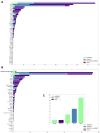Prevalence and Distribution Characteristics of blaKPC-2 and blaNDM-1 Genes in Klebsiella pneumoniae
- PMID: 32903853
- PMCID: PMC7445519
- DOI: 10.2147/IDR.S253631
Prevalence and Distribution Characteristics of blaKPC-2 and blaNDM-1 Genes in Klebsiella pneumoniae
Abstract
Background: Carbapenem-resistant Klebsiella pneumoniae infections have caused major concern and posed a global threat to public health. As blaKPC-2 and blaNDM-1 genes are the most widely reported carbapenem resistant genes in K. pneumonia, it is crucial to study the prevalence and geographical distribution of these two genes for further understanding of their transmission mode and mechanism.
Purpose: Here, we investigated the prevalence and distribution of blaKPC-2 and blaNDM-1 genes in carbapenem-resistant K. pneumoniae strains from a tertiary hospital and from 1579 genomes available in the NCBI database, and further analyzed the possible core structure of blaKPC-2 or blaNDM-1 genes among global genome data.
Materials and methods: K. pneumoniae strains from a tertiary hospital in China during 2013-2018 were collected and their antimicrobial susceptibility testing for 28 antibiotics was determined. Whole-genome sequencing of carbapenem-resistant K. pneumoniae strains was used to investigate the genetic characterization. The phylogenetic relationships of these strains were investigated through pan-genome analysis. The epidemiology and distribution of blaKPC-2 and blaNDM-1 genes in K. pneumoniae based on 1579 global genomes and carbapenem-resistant K. pneumoniae strains from hospital were analyzed using bioinformatics. The possible core structure carrying blaKPC-2 or blaNDM-1 genes was investigated among global data.
Results: A total of 19 carbapenem-resistant K. pneumoniae were isolated in a tertiary hospital. All isolates had a multi-resistant pattern and eight kinds of resistance genes. The phylogenetic analysis showed all isolates in the hospital were dominated by two lineages composed of ST11 and ST25, respectively. ST11 and ST25 were the major ST type carrying blaKPC-2 and blaNDM-1 genes, respectively. Among 1579 global genomes data, 147 known ST types (1195 genomes) have been identified, while ST258 (23.6%) and ST11 (22.1%) were the globally prevalent clones among the known ST types. Genetic environment analysis showed that the ISKpn7-dnaA/ISKpn27 -blaKPC-2-ISkpn6 and blaNDM-1-ble-trpf-nagA may be the core structure in the horizontal transfer of blaKPC-2 and blaNDM-1 , respectively. In addition, DNA transferase (hin) may be involved in the horizontal transfer or the expression of blaNDM-1 .
Conclusion: There was clonal transmission of carbapenem-resistant K. pneumoniae in the tertiary hospital in China. The prevalence and distribution of blaKPC-2 and blaNDM-1 varied by countries and were driven by different transposons carrying the core structure. This study shed light on the genetic environment of blaKPC-2 and blaNDM-1 and offered basic information about the mechanism of carbapenem-resistant K. pneumoniae dissemination.
Keywords: *blaNDM-1; Klebsiella pneumoniae; bioinformatics; blaKPC-2.
© 2020 Zhang et al.
Conflict of interest statement
All authors declare that they have no conflict of interest.
Figures




Similar articles
-
ST11 Carbapenem-Resistant Klebsiella pneumoniae Clone Harboring blaNDM Replaced a blaKPC Clone in a Tertiary Hospital in China.Antibiotics (Basel). 2022 Oct 7;11(10):1373. doi: 10.3390/antibiotics11101373. Antibiotics (Basel). 2022. PMID: 36290031 Free PMC article.
-
Large-scale comparative analysis reveals phylogenomic preference of blaNDM-1 and blaKPC-2 transmission among Klebsiella pneumoniae.Int J Antimicrob Agents. 2024 Aug;64(2):107225. doi: 10.1016/j.ijantimicag.2024.107225. Epub 2024 May 28. Int J Antimicrob Agents. 2024. PMID: 38810941
-
Microbial infection pattern, pathogenic features and resistance mechanism of carbapenem-resistant Gram negative bacilli during long-term hospitalization.Microb Pathog. 2018 Apr;117:356-360. doi: 10.1016/j.micpath.2018.02.025. Epub 2018 Feb 13. Microb Pathog. 2018. PMID: 29452198
-
Worldwide Dissemination of blaKPC Gene by Novel Mobilization Platforms in Pseudomonas aeruginosa: A Systematic Review.Antibiotics (Basel). 2023 Mar 28;12(4):658. doi: 10.3390/antibiotics12040658. Antibiotics (Basel). 2023. PMID: 37107020 Free PMC article. Review.
-
Klebsiella: a long way to go towards understanding this enigmatic jet-setter.F1000Prime Rep. 2014 Aug 1;6:64. doi: 10.12703/P6-64. eCollection 2014. F1000Prime Rep. 2014. PMID: 25165563 Free PMC article. Review.
Cited by
-
Risk Factors and Molecular Mechanism of Polymyxin B Resistance in Carbapenem-Resistant Klebsiella pneumoniae Isolates from a Tertiary Hospital in Fujian, China.Infect Drug Resist. 2022 Dec 15;15:7485-7494. doi: 10.2147/IDR.S391674. eCollection 2022. Infect Drug Resist. 2022. PMID: 36544993 Free PMC article.
-
Co-occurrence of Klebsiella variicola and Klebsiella pneumoniae Both Carrying bla KPC from a Respiratory Intensive Care Unit Patient.Infect Drug Resist. 2021 Oct 29;14:4503-4510. doi: 10.2147/IDR.S330977. eCollection 2021. Infect Drug Resist. 2021. PMID: 34744441 Free PMC article.
-
Decoding the genetic structure of conjugative plasmids in international clones of Klebsiella pneumoniae: A deep dive into blaKPC, blaNDM, blaOXA-48, and blaGES genes.PLoS One. 2023 Nov 16;18(11):e0292288. doi: 10.1371/journal.pone.0292288. eCollection 2023. PLoS One. 2023. PMID: 37971980 Free PMC article.
-
Large-Scale Genomic Epidemiology of Klebsiella pneumoniae Identified Clone Divergence with Hypervirulent Plus Antimicrobial-Resistant Characteristics Causing Within-Ward Strain Transmissions.Microbiol Spectr. 2022 Apr 27;10(2):e0269821. doi: 10.1128/spectrum.02698-21. Epub 2022 Apr 13. Microbiol Spectr. 2022. PMID: 35416698 Free PMC article.
-
Bacteriophage treatment is effective against carbapenem-resistant Klebsiella pneumoniae (KPC) in a neutropenic murine model of gastrointestinal translocation and renal infection.Antimicrob Agents Chemother. 2025 Feb 13;69(2):e0091924. doi: 10.1128/aac.00919-24. Epub 2024 Dec 20. Antimicrob Agents Chemother. 2025. PMID: 39704532 Free PMC article.
References
LinkOut - more resources
Full Text Sources
Research Materials
Miscellaneous

